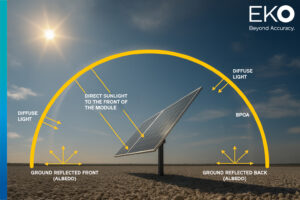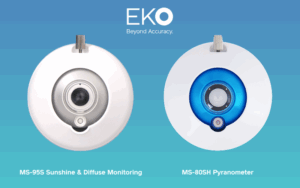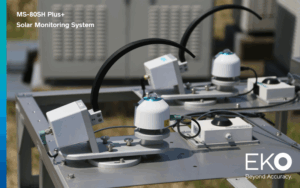In solar energy forecasting and PV monitoring, accurate diffuse irradiance measurement is essential to minimize error, reduce penalties, and ensure performance. As PV plants scale and grid demands intensify—especially with hybrid renewable systems and stricter energy balancing—accurate, traceable irradiance data is a requirement.
At the heart of solar performance modeling is Diffuse Horizontal Irradiance (DHI). Unfortunately, not all sensors are up to the task. In this article, we break down the role of different sensor strategies and explain why ISO 9060:2018 Class A pyranometers — especially integrated systems like the MS-80SH Plus+ — remain the gold standard for reliable DHI monitoring.

Estimating DHI: A Combined Strategy
Some monitoring solutions use a combination of sensors and pyranometers to estimate DHI. The EKO MS-95S excels in overcast conditions or when direct sunlight is absent. Paired with an MS-80SH pyranometer, it provides sky condition data to estimate DHI. This is useful for applications like positioning single-axis trackers during diffuse irradiance events. This Class A combination offers a cost-effective, flexible solution with easy integration without compromising quality.

Direct DHI Measurement for Precision
For precision-critical applications—such as bifacial PV plants, grid forecasting, or IEC 61724-1 Class A compliance—direct measurement is essential. The MS-80SH Plus+ solar monitoring station integrates an MS-80SH pyranometer with a direct-drive motorized shadow band to deliver traceable, repeatable, and bankable DHI data. It provides fast-response, spectrally flat thermopile measurements with outputs ready for SCADA integration.
The MS-80SH Plus+ is one of the most advanced all-in-one solar irradiance monitoring systems available today, and uniquely stands out—alongside high-end sun tracker-based systems—as the only true ISO 9060 Class A compliant solution for measuring GHI, DHI, and DNI. Unlike other compact irradiance sensors on the market that rely on mixed technologies, the MS-80SH Plus+ is built around a standard spectrally flat Class A pyranometer. This allows it to deliver highly accurate and consistent measurements across all solar components using the same thermopile-based detector technology.

Another major advantage of the MS-80SH Plus+ is its straightforward calibration process. As it uses a standard pyranometer, it can be easily calibrated by any ISO 17025-accredited calibration laboratory worldwide, rather than relying solely on the original manufacturer. Sensors with proprietary or hybrid technologies require manufacturer-specific calibration, causing logistical issues, downtime, and extra costs.
In summary, the MS-80SH Plus+ offers unmatched accuracy, ease of maintenance, and operational transparency. It is the only compact irradiance monitoring solution that delivers true Class A performance without compromise, ensuring reliable long-term data for solar energy, meteorology, and climate research applications.
Calibration & Maintenance
The MS-80SH Plus+ offers ISO/IEC 17025 traceable calibration, a 5-year recalibration interval, and minimal maintenance. Its brushless motor technology, shared with EKO’s sun trackers, ensures durability and precision for over a decade. This is ideal for long-term solar monitoring while reducing operational costs.
Existing PV plants can upgrade with the RSB-02 rotating shadow band and C-Box-S2 control unit, enhancing MS-80SH pyranometers to deliver GHI, DHI, and DNI data. This cost-effective upgrade brings legacy systems to ISO 9060 Class A standards without full replacement.
Suggested Image: Diagram of RSB-02 upgrade process, placed here to visualize the retrofit.
Bottom Line: Reliable Data for Solar Success
Whether choosing the MS-95S + MS-80SH for contextual monitoring or the MS-80SH Plus+ for direct DHI accuracy, EKO’s solutions build confidence in data, optimize plant performance, and ensure reliability in the evolving solar landscape.





